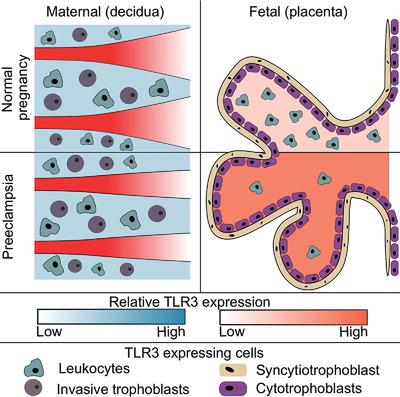当前位置:
X-MOL 学术
›
J. Leukoc. Biol.
›
论文详情
Our official English website, www.x-mol.net, welcomes your feedback! (Note: you will need to create a separate account there.)
TLR3 expression by maternal and fetal cells at the maternal-fetal interface in normal and preeclamptic pregnancies.
Journal of Leukocyte Biology ( IF 5.5 ) Pub Date : 2020-06-23 , DOI: 10.1002/jlb.3ma0620-728rr Lobke M Gierman 1, 2 , Gabriela B Silva 1, 2 , Zahra Pervaiz 1 , Johanne J Rakner 1 , Siv B Mundal 1 , Astrid J Thaning 1 , Ingunn Nervik 3 , Mattijs Elschot 4, 5 , Seema Mathew 2, 6 , Liv Cecilie V Thomsen 6, 7 , Line Bjørge 6, 7 , Ann-Charlotte Iversen 1, 2
Journal of Leukocyte Biology ( IF 5.5 ) Pub Date : 2020-06-23 , DOI: 10.1002/jlb.3ma0620-728rr Lobke M Gierman 1, 2 , Gabriela B Silva 1, 2 , Zahra Pervaiz 1 , Johanne J Rakner 1 , Siv B Mundal 1 , Astrid J Thaning 1 , Ingunn Nervik 3 , Mattijs Elschot 4, 5 , Seema Mathew 2, 6 , Liv Cecilie V Thomsen 6, 7 , Line Bjørge 6, 7 , Ann-Charlotte Iversen 1, 2
Affiliation

|
Inflammation and oxidative stress at the maternal‐fetal interface characterize the placental dysfunction that underlies the pregnancy disorder preeclampsia. Specialized fetal trophoblasts directly interact with leukocytes at both sites of the maternal‐fetal interface; the uterine wall decidua; and the placenta. TLR3 has been implicated in the harmful inflammation at the maternal‐fetal interface in preeclampsia, but the cellular involvement in the decidua and placenta has not been determined. This study aimed to characterize and quantify cell‐specific TLR3 expression and function at the maternal‐fetal interface in normal and preeclamptic pregnancies. TLR3 expression was assessed by immunohistochemistry and quantified by a novel image‐based and cell‐specific quantitation method. TLR3 was expressed at the maternal‐fetal interface by all decidual and placental trophoblast types and by maternal and fetal leukocytes. Placental, but not decidual, TLR3 expression was significantly higher in preeclampsia compared to normal pregnancies. This increase was attributed to placental intravillous tissue and associated with both moderate and severe placental dysfunction. TLR3 pathway functionality in the decidua and placenta was confirmed by TLR3 ligand‐induced cytokine response, but the TLR3 expression levels did not correlate between the two sites. In conclusion, functional TLR3 was broadly expressed by maternal and fetal cells at both sites of the maternal‐fetal interface and the placental intravillous expression was increased in preeclampsia. This suggests TLR3‐mediated inflammatory involvement with local regulation at both sites of the maternal‐fetal interface in normal and preeclamptic pregnancies.
中文翻译:

正常和先兆子痫孕妇中母婴界面处母体和胎儿细胞的TLR3表达。
母胎界面的炎症和氧化应激是胎盘功能障碍的特征,是胎盘功能异常的先兆子痫。专门的胎儿滋养细胞在母胎界面的两个部位直接与白细胞相互作用。子宫壁蜕膜; 和胎盘。TLR3与先兆子痫母婴界面的有害炎症有关,但尚未确定蜕膜和胎盘中的细胞受累情况。本研究旨在表征和定量正常和先兆子痫孕妇在母胎界面的细胞特异性TLR3表达和功能。通过免疫组织化学评估TLR3的表达,并通过基于图像和细胞特异性的新型定量方法对其进行定量。在所有的蜕膜和胎盘滋养细胞类型以及母体和胎儿白细胞中,TLR3均在母胎界面表达。与正常妊娠相比,先兆子痫的胎盘TLR3表达明显升高,但并非蜕膜。这种增加归因于胎盘绒毛内组织,并与中度和重度胎盘功能障碍有关。TLR3配体诱导的细胞因子反应证实了蜕膜和胎盘中的TLR3途径功能,但两个部位之间的TLR3表达水平无关。总之,功能性TLR3在母胎界面的两个部位均由母体和胎儿细胞广泛表达,子痫前期胎盘绒毛内表达增加。
更新日期:2020-06-23
中文翻译:

正常和先兆子痫孕妇中母婴界面处母体和胎儿细胞的TLR3表达。
母胎界面的炎症和氧化应激是胎盘功能障碍的特征,是胎盘功能异常的先兆子痫。专门的胎儿滋养细胞在母胎界面的两个部位直接与白细胞相互作用。子宫壁蜕膜; 和胎盘。TLR3与先兆子痫母婴界面的有害炎症有关,但尚未确定蜕膜和胎盘中的细胞受累情况。本研究旨在表征和定量正常和先兆子痫孕妇在母胎界面的细胞特异性TLR3表达和功能。通过免疫组织化学评估TLR3的表达,并通过基于图像和细胞特异性的新型定量方法对其进行定量。在所有的蜕膜和胎盘滋养细胞类型以及母体和胎儿白细胞中,TLR3均在母胎界面表达。与正常妊娠相比,先兆子痫的胎盘TLR3表达明显升高,但并非蜕膜。这种增加归因于胎盘绒毛内组织,并与中度和重度胎盘功能障碍有关。TLR3配体诱导的细胞因子反应证实了蜕膜和胎盘中的TLR3途径功能,但两个部位之间的TLR3表达水平无关。总之,功能性TLR3在母胎界面的两个部位均由母体和胎儿细胞广泛表达,子痫前期胎盘绒毛内表达增加。



























 京公网安备 11010802027423号
京公网安备 11010802027423号